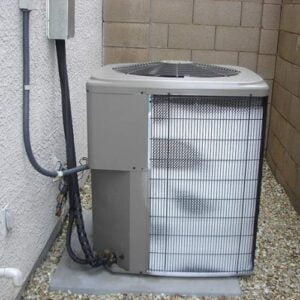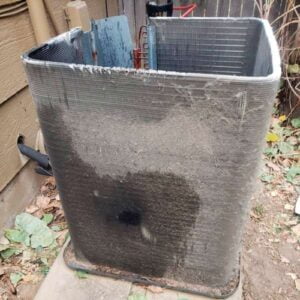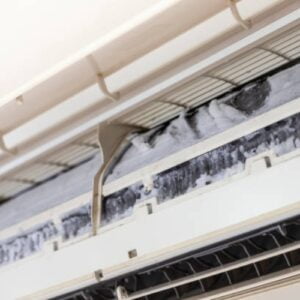7 Tips to Stop Ice Build-Up
An all-too-common issue that can significantly impede the efficiency and effectiveness of your AC is the unexpected and often perplexing phenomenon of ice build-up. This can not only lead to discomfort in your own home but also signal deeper problems within your HVAC system that require immediate attention.
Understanding the root causes of this frosty problem, how to effectively address it, and implementing strategies to prevent its recurrence are essential steps in ensuring your summer days remain cool and comfortable. This blog will explore the intricacies of ice build-up on AC units, demystifying why it happens, offering solutions to thaw out the issue, and providing practical advice to maintain your AC unit in pristine condition. Whether you’re a seasoned homeowner or new to the nuances of home maintenance, this guide aims to arm you with the knowledge and tools needed to tackle ice build-up head-on, ensuring your air conditioning unit continues to operate smoothly throughout the hottest days of the year.
Understanding the Freeze: Why Does Ice Build-Up Occur?
Ice build-up on an air conditioning unit is a clear signal that something within the system isn’t functioning as it should. This phenomenon can be both confusing and frustrating for homeowners, especially during the hot summer months when AC is most needed. Understanding why ice forms on your AC unit is the first step towards solving the problem and preventing future occurrences. Let’s delve into the primary reasons behind this chilly issue:
1. Low Refrigerant Levels
The refrigerant is the lifeblood of any air conditioning system, responsible for absorbing heat from inside your home and releasing it outdoors. When there are leaks in the system, or if it was undercharged during installation, the level of refrigerant drops. This decrease causes the evaporator coils to get too cold, leading to condensation and eventually, ice formation. It’s a clear sign that your system needs a refrigerant recharge and possibly a leak repair.
2. Inadequate Airflow
Proper airflow across the evaporator coils is crucial for the AC unit to function correctly. When airflow is restricted, due to a dirty air filter, blocked air return vents, or a malfunctioning fan, the evaporator coils can get too cold and freeze the condensation that forms on them. Regularly checking and replacing your air filters and ensuring that vents are not obstructed can help mitigate this issue.
3. Dirty Coils
Over time, the evaporator coils can become coated in dust, dirt, and other debris. This layer of grime can insulate the coils, preventing them from absorbing heat effectively and causing the temperature to drop below freezing, leading to ice build-up. Keeping the coils clean is essential for the efficient operation of your AC unit.
4. Faulty Components
Several mechanical issues can lead to freezing in your AC unit. A malfunctioning thermostat, a damaged blower motor, or issues with the refrigerant lines can all contribute to the problem. These components play a crucial role in the functioning of your AC system, and any issues with them can disrupt the delicate balance required to keep the system running smoothly.
By understanding the root causes of ice build-up on your AC unit, you can take proactive steps to address the issue. Whether it’s performing regular maintenance, like changing air filters and cleaning coils, or calling in a professional to fix leaks and replace faulty components, addressing these issues promptly can help keep your AC unit running efficiently and extend its lifespan. Remember, an ounce of prevention is worth a pound of cure, especially when it comes to maintaining your home’s cooling system.
Thawing the Problem: Steps to Fix Ice Build-Up
Once you’ve recognized the frosty issue of ice build-up on your AC unit, the next step is to address it effectively to restore your system’s functionality and efficiency. Here are step-by-step solutions to thaw the problem and get your AC running smoothly again:
Step 1: Turn Off Your AC Unit
The immediate action to take when you notice ice on your AC unit is to turn it off. Continuing to run the system can cause further damage to the components. Switch off the unit at the thermostat and, if necessary, at the breaker panel to ensure it is completely powered down. This will allow the ice to begin melting naturally, a process that can take several hours depending on the extent of the build-up.
Step 2: Check and Replace the Air Filter
A clogged air filter is one of the most common causes of restricted airflow, leading to ice formation. Check your air filter and replace it if it’s dirty. This is a simple and cost-effective maintenance task that can prevent many airflow-related issues in your AC system.
Step 3: Clean the Coils and Fins
Once the ice has fully melted, inspect the evaporator coils and fins for dirt and debris. If they are dirty, gently clean them using a soft brush or a commercially available coil cleaner. Be careful not to bend the fins or damage the coils, as this can affect the system’s efficiency.
Step 4: Inspect and Seal Refrigerant Leaks
If you suspect that low refrigerant levels are the cause of the ice build-up, it’s crucial to have a professional HVAC technician inspect the system. Handling refrigerant requires special training and equipment, and leaks need to be accurately identified and sealed before recharging the system.
Step 5: Ensure Proper Airflow
Make sure all registers and vents are open and unobstructed to allow for proper airflow throughout your home. If you have adjustable vents, ensure they’re positioned for optimal air distribution. Consider having your ductwork inspected for leaks, blockages, or insulation issues if airflow problems persist.
Step 6: Schedule Professional Maintenance
Regular maintenance by a certified HVAC technician is essential for identifying and rectifying issues before they lead to ice build-up. These professionals can perform a comprehensive check of your system, including inspecting the blower motor, thermostat, refrigerant levels, and electrical connections.
Step 7: Monitor and Adjust Your AC Usage
Sometimes, the way we use our AC units can contribute to problems. Avoid setting your thermostat to excessively low temperatures, as this can overwork the system and lead to freezing. Instead, find a comfortable setting that allows the unit to maintain a stable temperature without overexertion.
By following these steps, you can effectively address ice build-up on your AC unit, ensuring it operates efficiently and keeps your home comfortably cool. Remember, regular maintenance and prompt attention to potential issues can prevent most cases of ice formation, saving you time, money, and discomfort in the long run.
Preventive Measures: Keeping Your AC Ice-Free
To ensure your air conditioning unit remains efficient, effective, and ice-free, proactive preventive measures are key. These strategies not only extend the life of your AC unit but also enhance its performance, ensuring a cool and comfortable home environment during the hottest days. Here are essential preventive measures to keep your AC ice-free:
1. Regular Maintenance Checks
Schedule regular professional maintenance checks for your AC unit, ideally before the start of the cooling season. These checks can identify and address potential issues such as low refrigerant levels, dirty coils, and inadequate airflow before they lead to ice build-up. A well-maintained AC unit operates more efficiently and is less likely to encounter issues.
2. Clean or Replace Air Filters Regularly
One of the simplest yet most effective preventive measures is to regularly clean or replace your AC unit’s air filters. A clean filter ensures optimal airflow, preventing the evaporator coils from freezing over. Depending on your usage and the type of filters, you should clean or replace them every 1-3 months.
3. Keep the Area Around the Unit Clear
Ensure the outdoor component of your AC unit (the condenser) has enough clearance for proper air intake. Keep plants trimmed and remove any debris around the unit to prevent airflow blockages. This not only prevents ice build-up but also enhances the overall efficiency of your system.
4. Monitor Thermostat Settings
Avoid setting your thermostat to excessively low temperatures, as it can overwork your AC unit and lead to freezing. Find a comfortable temperature setting that allows the unit to maintain a stable indoor climate without constant, strenuous operation.
5. Insulate and Seal Ductwork
Proper insulation and sealing of ductwork help maintain consistent temperatures within the ducts, preventing condensation and freezing issues. Inspect your ductwork for leaks or inadequate insulation and have any issues repaired to improve the efficiency of your AC system.
6. Use a Programmable Thermostat
A programmable thermostat can help regulate your AC’s operation, ensuring it runs most efficiently. Setting your thermostat to adjust the indoor temperature while you’re away or asleep can prevent overuse of the AC unit, reducing the risk of freezing and saving energy.
7. Consider Upgrading Your Unit
If your AC unit is old and frequently experiences problems, including ice build-up, it may be time to consider an upgrade. Newer models are more energy-efficient, less prone to operational issues, and often come with advanced features that improve cooling performance and reduce the likelihood of freezing.
8. Educate Yourself and Your Household
Understanding how your AC unit works and educating your household on proper AC usage and maintenance can go a long way in preventing issues. Awareness of the signs of potential problems, such as unusual noises or decreased cooling efficiency, can prompt early intervention before ice build-up occurs.
By implementing these preventive measures, you can enjoy a seamless cooling experience throughout the hot months, keeping your home comfortable and your AC unit in top condition. Regular attention to maintenance and operation can prevent the inconvenience and discomfort of ice build-up, ensuring your summer days are cool and worry-free.
Maintenance
Maintaining your air conditioning unit is crucial for ensuring it runs efficiently, lasts longer, and doesn’t succumb to common issues like ice build-up. A well-maintained AC system not only provides reliable cooling but also operates more economically, saving you money on energy bills and potential repair costs. Here’s a comprehensive guide to AC maintenance that can help prevent ice build-up and keep your unit performing at its best.
Regular Maintenance Schedule
1. Professional Servicing: Schedule at least one professional maintenance check annually, ideally before the cooling season begins. A certified HVAC technician can thoroughly inspect your system, clean components, check refrigerant levels, and identify any potential issues.
2. Air Filter Replacement: Check and replace your AC’s air filters every 1-3 months, depending on use and the type of filter. A clean air filter ensures optimal airflow, significantly reducing the risk of ice build-up.
DIY Maintenance Tasks
1. Cleaning the Condenser Unit: The outdoor condenser unit should be kept clean and free of debris. Gently remove leaves, dirt, and other debris from the fins using a soft brush or a garden hose (do not use a pressure washer, as it can damage the fins).
2. Checking and Cleaning the Evaporator Coil: Accessing the evaporator coil may be more challenging and varies by unit, but keeping it clean is essential. If accessible, use a soft brush and coil cleaner to remove buildup that can impede heat absorption.
3. Inspecting the Condensate Drain: Check the condensate drain for clogs that can lead to water leakage and potential damage. A clogged drain can also affect humidity levels, indirectly contributing to cooling issues and discomfort.
Seasonal Preparations
1. Pre-Summer Check: Before the start of the summer season, ensure your system is ready to handle the increased demand. This includes checking refrigerant levels, inspecting wiring and controls, and ensuring the thermostat is functioning correctly.
2. winterizing: If you live in an area with cold winters and won’t be using your AC, consider covering the outdoor unit to protect it from debris and winter weather. However, ensure that the cover is breathable to prevent condensation and rusting.
Energy Efficiency Tips
1. Thermostat Settings: Use a programmable thermostat to set your AC to warmer temperatures when you’re not home and cooler temperatures when you are. This reduces the workload on your AC and prevents unnecessary cooling.
2. Use of Fans: Ceiling or oscillating fans can enhance the cooling effect of your AC, allowing you to set the thermostat a few degrees higher without reducing comfort. This also helps in evenly distributing the cool air throughout the room.
3. Sealing and Insulation: Ensure that your home is well-sealed and insulated to prevent cool air from escaping. Check windows, doors, and ductwork for leaks and have them sealed to improve your AC’s efficiency.
Strategies to Vanquish Ice Build-Up on Your AC Unit – A Guide by Your AC Therapist
In the grand scheme of home maintenance, particularly during the relentless heat waves of summer, understanding the nuances of preventing and resolving ice build-up on your air conditioning unit transcends basic home care—it embodies a commitment to ensuring your living space remains an oasis of comfort and efficiency. As your AC Therapist, my mission extends beyond providing temporary fixes; it’s about equipping you with comprehensive knowledge and long-term strategies to enhance the health and performance of your cooling system.
The seven advanced strategies we’ve explored together are not merely tips; they are pillars of wisdom that support a holistic approach to combating the common yet disruptive issue of AC ice build-up. From the criticality of maintaining unimpeded airflow with meticulously cleaned or replaced filters, to the undeniable value of regular professional maintenance checks, each strategy is a step towards optimizing your AC unit’s efficiency, prolonging its lifespan, and securing your home’s comfort.
Embarking on this journey of proactive AC maintenance signifies a deeper understanding of the symbiotic relationship between your living environment and the appliances that sustain it. It’s about recognizing that each action taken to prevent ice build-up not only safeguards your AC unit but also contributes to a larger narrative of energy conservation, cost savings, and environmental stewardship.
As we wrap up our discussion, I urge you to see these strategies as more than a checklist. View them as foundational components of a sustainable, comfortable home. Whether through adjusting thermostat habits to lessen the burden on your AC, leveraging ceiling fans to complement your cooling efforts, or ensuring your home is sealed and insulated to maximize cool air retention, every measure you implement is a stride towards a more harmonious home environment.
The path to overcoming AC ice build-up challenges may seem daunting at first glance, but with informed strategies and a proactive mindset, it is undoubtedly navigable. And remember, this journey is not one you embark upon in solitude. As your AC Therapist, I stand ready to offer my guidance, support, and professional expertise to navigate the complexities of air conditioning maintenance together.
Facing the frosty challenge of ice build-up on your AC unit is a testament to your dedication to maintaining a serene, efficient living space. With vigilance, proactive care, and the willingness to seek expert advice when necessary, you can triumph over any cooling system obstacles.
Trust in the journey, lean on the expertise of your AC Therapist, and look forward to a future where your home remains an unwavering haven of cool, inviting comfort, no matter the temperature outside. Your commitment to these principles ensures that your air conditioning system will continue to serve you effectively, keeping your sanctuary perfectly chilled throughout the searing summer months and beyond.













